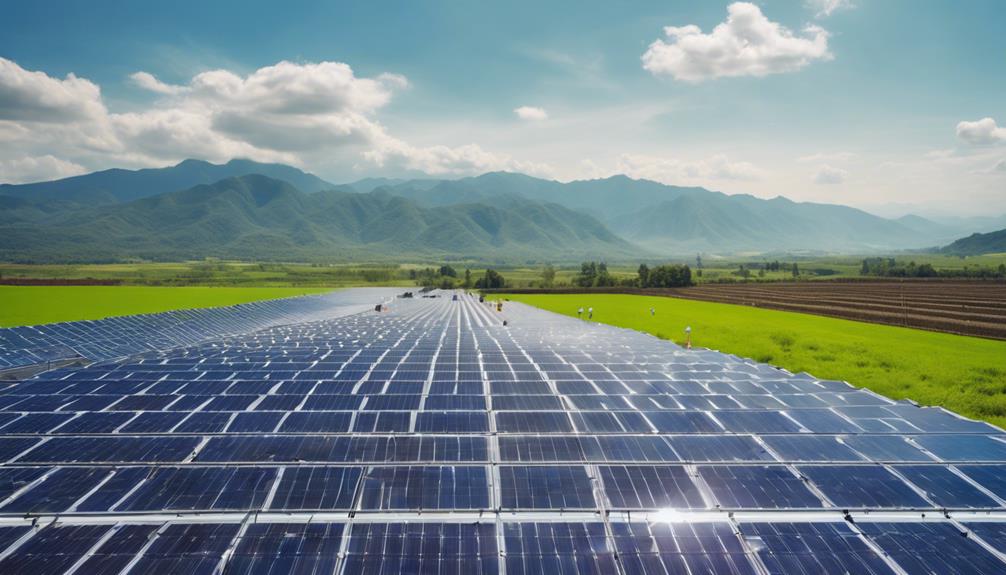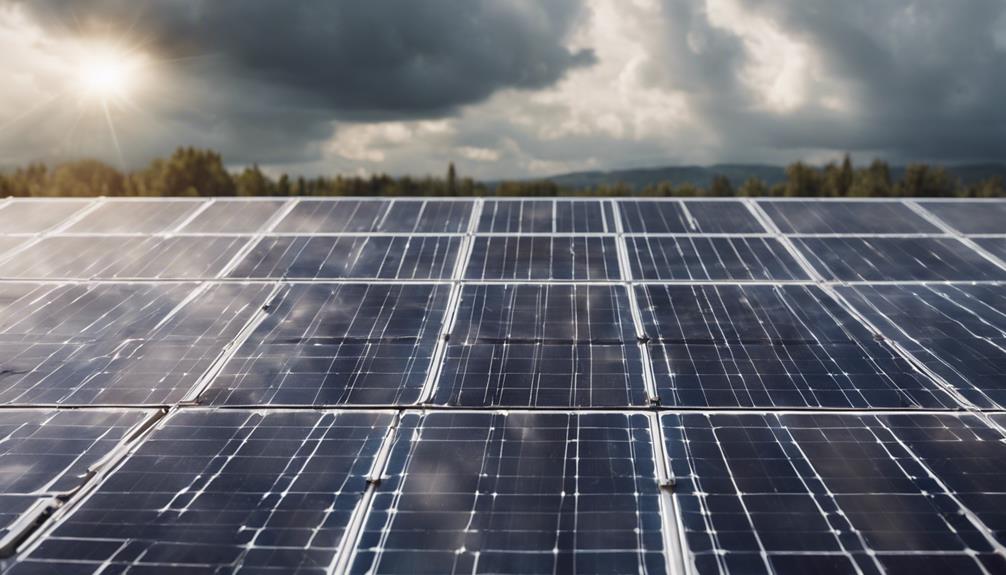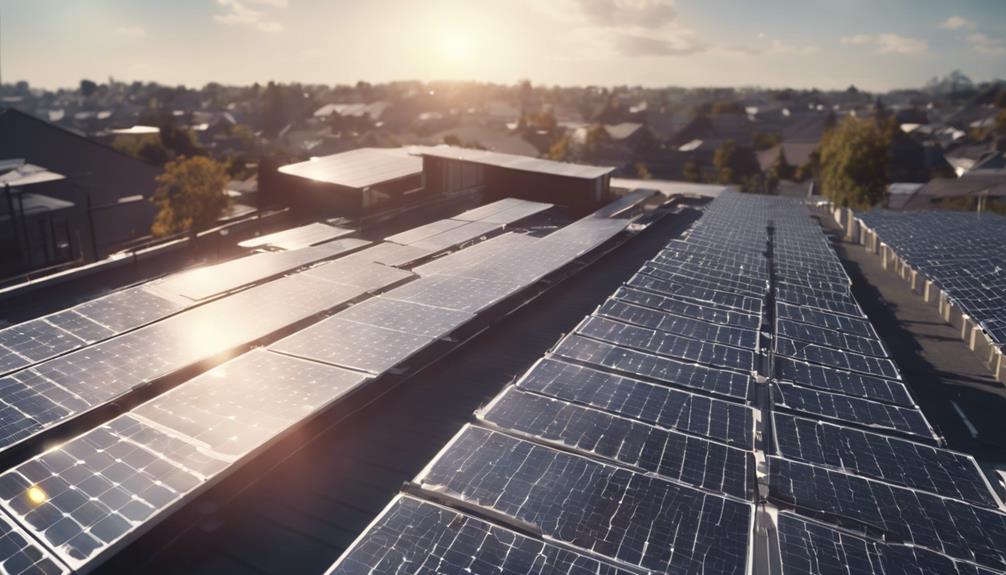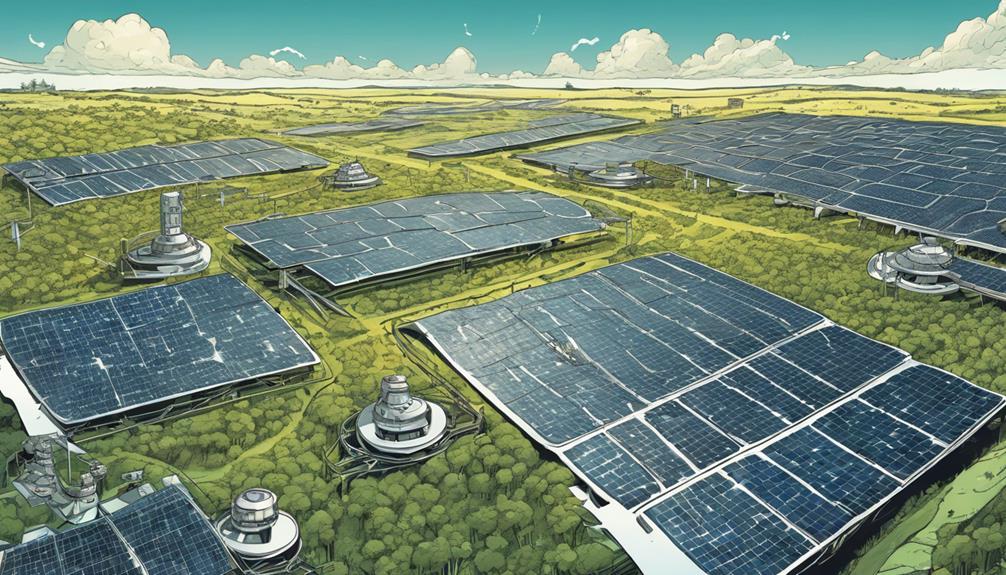You get solar energy mainly from the sun. It's a huge and sustainable power source that powers photovoltaic cells to create electricity. It's used in homes, businesses, and cities. Solar energy history dates back to ancient times, with the photovoltaic effect discovered in 1839. Solar panels are vital for various applications, and their efficiency affects electricity production. Factors like materials quality impact their effectiveness. Understanding solar PV versus solar thermal helps in choosing the right technology. Cloud cover and quality of panels also affect solar generation. Usage statistics show an increasing trend, and various solar technologies harness renewable energy.
Key Takeaways
- Solar energy is obtained from the sun through photovoltaic cells.
- Photons are converted into electricity by photovoltaic cells.
- Solar thermal systems generate heat sustainably from solar energy.
- Concentrating solar power plants produce electricity on a large scale.
- Abundance of solar energy globally ensures sustainable power generation.
Solar Energy Sources
Solar energy sources mainly derive from the sun, where photons are converted into electricity through photovoltaic cells. This renewable energy is an essential player in powering homes and businesses worldwide. Photovoltaic technology plays a significant role in harnessing solar power by absorbing sunlight and generating an electric current.
Additionally, solar thermal systems are used to capture solar energy to heat water or fluids, providing sustainable solutions for various applications.
Concentrating solar power plants are another innovative way to utilize solar energy efficiently. By using mirrors to concentrate sunlight onto receivers, these plants can generate electricity on a larger scale. The abundance of solar energy sources globally offers a promising future for sustainable power generation.
With the potential to power not only individual homes but also entire cities, solar energy is proving to be a crucial component in the shift towards cleaner and more environmentally friendly energy sources.
Solar Power Discovery

You may be surprised to learn that solar energy has a rich history, dating back to ancient civilizations like the Greeks and Romans who used mirrors to capture sunlight.
The pivotal discovery of the photovoltaic effect by French physicist Edmond Becquerel in 1839 laid the foundation for modern solar power technology.
Fast forward to 1954 when the first silicon photovoltaic cell was developed at Bell Labs, marking a significant milestone in the evolution of solar energy.
Early Solar Use
Back in the 7th century B.C., humans began utilizing solar energy, marking the early adoption of this renewable resource in history.
Ancient civilizations like the Greeks and Romans utilized mirrors to harness solar power as early as the 3rd century B.C., showcasing innovative early uses of solar energy.
The discovery of the photovoltaic effect by French physicist Edmond Becquerel in 1839 laid the foundation for solar power generation.
A significant milestone in solar technology was the development of the first silicon photovoltaic cell in 1954 at Bell Labs. This breakthrough paved the way for the integration of solar energy into various applications, including powering satellites and spacecraft.
The reliability and efficiency of solar energy in space highlight its versatility and effectiveness.
Throughout history, from early uses with mirrors to modern advancements in photovoltaic cells, solar energy has proven to be a sustainable and valuable source of power.
Photovoltaic Effect Discovery
How did the discovery of the photovoltaic effect by French physicist Edmond Becquerel in 1839 revolutionize the utilization of solar power?
Edmond Becquerel's groundbreaking discovery revealed that certain materials could release electrons when exposed to sunlight, leading to the generation of an electric current. This phenomenon, known as the photovoltaic effect, laid the foundation for the development of solar photovoltaic technology.
Solar panels, which harness the power of sunlight to produce electricity, rely on this pivotal principle. By converting sunlight into usable energy through the photovoltaic effect, solar panels have become instrumental in various applications, from generating electricity for homes to powering spacecraft in outer space.
Becquerel's discovery not only opened up new possibilities for utilizing solar power but also paved the way for advancements in renewable energy technology, emphasizing the importance of understanding and harnessing the natural energy sources available to us.
Electricity Production From Solar

Solar panel efficiency and grid integration methods are vital aspects of electricity production from solar.
Understanding how efficiently solar panels convert sunlight into electricity and how this power is seamlessly integrated into existing electrical grids is critical.
Let's explore these key points to grasp the full impact of solar energy on our electricity production systems.
Solar Panel Efficiency
Efficient solar panels are essential for maximizing electricity production from solar energy systems. Solar panel efficiency refers to the percentage of sunlight converted into electricity, typically ranging from 15% to 22%. High-efficiency panels can exceed 22%, while lower-cost options hover around 15%. Improving solar panel efficiency boosts electricity production per square foot, impacted by factors like materials quality, design, temperature, shading, and orientation towards the sun. Investing in higher efficiency panels leads to increased energy savings and quicker returns on investment in solar systems.
| Factors Affecting Solar Panel Efficiency | Impact |
|---|---|
| Materials Quality | High |
| Design | High |
| Temperature | Medium |
| Shading Effects | High |
| Orientation Efficiency | High |
Grid Integration Methods
Integrating solar energy into the grid involves various methods to enhance electricity production efficiency and grid stability. Grid integration techniques such as net metering allow excess electricity produced by solar panels to be fed back into the grid for credit.
Smart inverters play an essential role in managing voltage and frequency fluctuations caused by solar power, ensuring grid stability. Energy storage systems are utilized by solar power plants to store surplus energy, which can be discharged during peak demand periods, optimizing grid performance.
Advanced forecasting tools are employed by grid operators to predict solar energy generation accurately, enabling efficient electricity distribution. Additionally, microgrid systems integrated with solar energy provide localized power generation, enhancing resilience during grid outages or emergencies.
Solar PV Vs. Solar Thermal

When considering solar energy options, you may find yourself weighing the differences between Solar PV and Solar Thermal technologies. Solar PV panels utilize the photovoltaic effect to convert sunlight directly into electricity, making them ideal for electricity generation.
On the other hand, solar thermal panels use sunlight to heat water or fluids, primarily for heating applications. Solar PV technology is often found on rooftops for electricity generation, while solar thermal technology is commonly used for water heating in residential and commercial settings.
Both technologies harness solar energy efficiently, but their design and application differ substantially. Solar PV excels in producing electricity, while solar thermal is preferred for heating purposes.
Understanding these distinctions can help you choose the right technology based on your specific needs, whether it's generating electricity or fulfilling heating requirements.
Solar Farms Overview

Solar farms, also known as solar power plants, are large-scale installations with interconnected solar panels designed for generating significant amounts of solar energy. These farms play a pivotal role in scaling up solar energy production by feeding directly into the grid, contributing to widespread energy distribution.
Unlike individual solar panels on buildings, solar farms can harvest solar power on a larger scale, reducing reliance on fossil fuels and meeting energy demands efficiently. By harnessing solar energy in bulk, solar farms are essential for driving the shift towards cleaner energy sources. They're essential components of the renewable energy landscape, ensuring a more sustainable future by maximizing the potential of solar power.
With the ability to generate significant amounts of electricity and distribute it efficiently, solar farms are key players in the ongoing shift towards a greener and more environmentally friendly energy sector.
Solar Generation on Cloudy Days

Generating solar power on cloudy days requires efficient solar panels and sufficient daylight to maintain electricity production levels. The amount of direct sunlight and the quality of solar panels significantly impact the generation rate of solar power during cloudy weather. Even with decreased sunlight, solar panels can still harness the sun's energy to produce electricity. While the efficiency of solar panels may decrease on cloudy days, they can still contribute electricity to the grid. Cloudy weather does not completely hinder solar power generation, as some level of daylight is sufficient for solar panels to generate electricity.
| Factors Affecting Solar Generation on Cloudy Days | Impact |
|---|---|
| Level of Daylight | Affects electricity production levels |
| Quality of Solar Panels | Determines the generation rate |
| Amount of Direct Sunlight | Impacts efficiency of solar panels |
| Efficiency of Solar Panels | Influences the contribution to the grid |
| Cloud Cover | Determines if daylight is sufficient |
Solar Energy Usage Statistics

During cloudy days, understanding solar energy usage statistics can provide valuable insights into the impact of solar power on electricity generation. Here are some key facts regarding solar energy usage in the United States:
- Solar energy currently contributes approximately 3% to the total electricity generation in the U.S.
- The solar industry plays a significant role in the American economy, providing jobs for over 230,000 individuals nationwide.
- California leads the nation in solar energy capacity, boasting over 27 GW of installed solar power.
- Over the past decade, solar capacity in the U.S. has expanded by more than 20 times, showcasing remarkable growth in the adoption of solar energy.
As technology advances and costs of solar installations decrease, the usage of solar energy is projected to continue its upward trajectory. These usage statistics highlight the increasing importance of solar power in the nation's energy mix and its potential for further expansion in the future.
Solar Technologies Overview

When looking at renewable energy sources, one can't ignore the diverse array of solar technologies available for harnessing the sun's power. Solar technologies encompass photovoltaics, solar heating & cooling, and concentrating solar power.
Photovoltaics are adept at converting sunlight into electricity, catering to a wide range of applications from small electronics to large-scale installations.
Solar heating & cooling systems efficiently utilize solar heat for tasks such as water heating, space heating, and air conditioning.
On the other hand, concentrating solar power plants utilize mirrors to concentrate sunlight, enabling electricity generation in utility-scale power stations.
These solar technologies collectively harness the abundant and renewable energy from the sun to meet diverse energy needs. By tapping into solar power through these various technologies, communities and industries can reduce their carbon footprint and move towards a more sustainable energy future.
Frequently Asked Questions
Where Does Solar Energy Come From?
Solar energy comes from the sun, harnessing photons to generate electricity or heat. Photovoltaic cells in solar panels convert sunlight into electricity. Solar thermal systems capture the sun's heat for various applications. It's a clean, abundant source of energy.
Where Does the Earth Get Solar Energy From?
You get solar energy from the Sun, located 93 million miles away. Sunlight, containing energy-carrying photons, reaches Earth. The atmosphere and clouds can scatter and absorb some energy. It's essential for photosynthesis, wind patterns, and temperature regulation.
Where Is the Main Source of Energy in Our Solar System?
Look up to the skies; the Sun, our star, radiates energy as the main source in our solar system. It provides light, heat, and power for all planets. Harness its energy wisely.
Where Is Solar Energy Received From?
You get solar energy from the sun, which radiates sunlight. The Earth receives an average of 164 watts per square meter. Solar technologies like photovoltaic panels convert this abundant energy into electricity, varying by location and conditions.
How Does Solar Energy Work and Where Is It Sourced From?
Solar energy works through the process of energy transformation in solar calculator operation, where sunlight is harnessed and converted into electricity. This renewable energy is sourced from the sun, which emits photons that are captured by solar panels and transformed into usable electrical energy through photovoltaic cells.
Conclusion
So, where do we get solar energy?
It comes from the sun, of course!
With solar power discovery leading to electricity production through solar PV and solar thermal technologies, we can harness the sun's energy to power our homes and businesses.
But did you ever stop to think just how much energy we could generate if we fully embraced solar technology?
The possibilities are endless.










